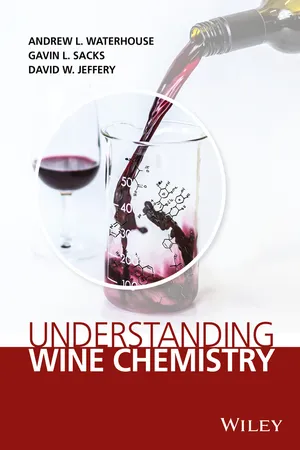
- English
- ePUB (mobile friendly)
- Available on iOS & Android
Understanding Wine Chemistry
About this book
Wine chemistry inspires and challenges with its complexity, and while this is intriguing, it can also be a barrier to further understanding. The topic is demystified in Understanding Wine Chemistry, Special Mention awardee in the 2018 OIV awards, which explains the important chemistry of wine at the level of university education, and provides an accessible reference text for scientists and scientifically trained winemakers alike.
Understanding Wine Chemistry:
- Summarizes the compounds found in wine, their basic chemical properties and their contribution to wine stability and sensory properties
- Focuses on chemical and biochemical reaction mechanisms that are critical to wine production processes such as fermentation, aging, physiochemical separations and additions
- Includes case studies showing how chemistry can be harnessed to enhance wine color, aroma, flavor, balance, stability and quality.
This descriptive text provides an overview of wine components and explains the key chemical reactions they undergo, such as those controlling the transformation of grape components, those that arise during fermentation, and the evolution of wine flavor and color. The book aims to guide the reader, who perhaps only has a basic knowledge of chemistry, to rationally explain or predict the outcomes of chemical reactions that contribute to the diversity observed among wines. This will help students, winemakers and other interested individuals to anticipate the effects of wine treatments and processes, or interpret experimental results based on an understanding of the major chemical reactions that can occur in wine.
Frequently asked questions
- Essential is ideal for learners and professionals who enjoy exploring a wide range of subjects. Access the Essential Library with 800,000+ trusted titles and best-sellers across business, personal growth, and the humanities. Includes unlimited reading time and Standard Read Aloud voice.
- Complete: Perfect for advanced learners and researchers needing full, unrestricted access. Unlock 1.4M+ books across hundreds of subjects, including academic and specialized titles. The Complete Plan also includes advanced features like Premium Read Aloud and Research Assistant.
Please note we cannot support devices running on iOS 13 and Android 7 or earlier. Learn more about using the app.
Information
Part B
Chemistry of Wine Production Processes
19
Outline of Wine Production
19.1 Introduction
| Description | Color | Residual sugar (g/L) | Alcohol (% v/v) | Examples | |
| White wines | |||||
| Still | Dry | Pale straw to gold | <9 | 8 to 14.5 | Riesling, Chardonnay, Semillon, Sauvignon Blanc, Colombard, Grüner Veltliner, Trebbiano, Chenin Blanc |
| Sweet | Light yellow to gold | 9 to 30 (semi‐sweet) | Riesling, Gerwurztraminer, Semillon | ||
| 30 to 200 (sweet) | Riesling, Ice wines, Sauternes, Tokay | ||||
| Sparkling | Dry to semi‐sweet | Pale straw to amber (pink to light red for rosé wines) | 0 to 50 | Champagne, Chardonnay/Pinot Noir/Pinot Meuniera, Riesling, Sauvignon Blanc, Cava, Prosecco | |
| Fortified | Dry | Pale straw to amber | 0 to 30 | 15 to 20.5 | Fino and Amontillado Sherries |
| Sweet | 100 to 300 | Oloroso and Pedro Ximénezb Sherries, Topaque | |||
| Red wines | |||||
| Still | Dry | Dark red to red/brown | <7.5 | 8 to 14.5 | Grenache, Merlot, Cabernet Sauvignon, Tempranillo, Zinfandel, Sangiovese, Malbec, Pinot Noir, Shiraz |
| Sparkling | Semi‐sweet | 7.5 to 30 | Pinot Noir, Shiraz, Cabernet Sauvignon | ||
| Fortified | Sweet | Red/gold to deep brown | 100 to 300 | 18 to 22 | Ruby, Tawny and Vintage Ports, Brown Muscat |
19.2 Basic workflow
- White grapes are crushed/destemmed and pressed to juice and do not typically spend much time in contact with grape solids (i.e., there is no maceration step).
- Red grapes are crushed/destemmed and the must (juice and grape solids) undergoes maceration and fermentation in the presence of skins, seeds and juice (Chapter 21).
- As a result of the above, extraction of polyphenols is mostly avoided with white wines and encouraged in red wine production.
- Cooler temperatures are used for white fermentations to control aroma characteristics and warmer temperatures enhance extraction of solids in reds.
- White fermentations mostly exclude oxygen, whereas some aeration is encouraged during red winemaking through the maceration techniques employed.
- The majority of red wines undergo malolactic fermentation (MLF) and incorporation of oak in contrast to white wines, where only certain styles experience these treatments.
- Red wines undergo a period of maturation in tanks or oak barrels to promote stabilization of color and modification of mouthfeel.
- White wines can be released much earlie...
Table of contents
- Cover
- Title Page
- Table of Contents
- Foreword
- Preface
- Introduction
- Part A: Wine Components and Their Reactions
- Part B: Chemistry of Wine Production Processes
- Part C: Case Studies: Recent Advances in Wine Chemistry
- Index
- End User License Agreement